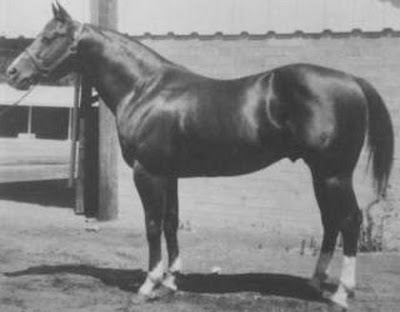For simplicities sake, I figure inbreeding is the mating of two direct relatives within two generations. This means, father to daughter, mother to son, full brother to full sister or 1/2 brother to 1/2 sister. Linebreeding is the mating of two horses with similar bloodlines. There is a common ancestor that will appear at least two times in the resulting foal's pedigree within 5 generations.
It's all the other crazy mixes between those two distinct and seperate theories that cause confusion. And there are a lot of them. All you have to do is look at a few pedigrees. Some of those criss-crossy matches even make me scratch my head.
Genetically speaking...the reasons for inbreeding is to produce Homozygosity. From the colonial days, inbreeding has been used to "fix" certain characteristics that define a "type". The QH can trace his origins back a couple hundred years to one particular horse, Janus. Colonial breeders being limited on the number of quality race-type horses, crossed Janus back on his own fillies, bred full brothers and sisters, 1/2 brothers and sisters and unwittingly created a type of horse that was known for it's ability to break quickly at the starting line and for it's short bursts of speed. Discussion and conjecture says that these types of horses could not even maintain their speed for a quarter mile, so other bloodlines had to be infused to create a horse that not only maintained the abilities the inbred Janus' had, but could still run far enough to at least make it a race and hence the quarter miler was born. Well, at least the concepts were there. And so was the concept of inbreeding and outcrosses. Now, I am pretty sure that such ideas were around long before the colonies...as there were already established "types" of horses...Arabians, English TB's, Andalusians, Friesians and several draft-types, to name a few. We cannot be so arrogent or narrow-minded to think that any type or breed of horse in existance today was EVER created without some type of inbreeding and linebreeding.
Alright, so the next question is, since we now have a breed, why do we still need inbreeding? Welll...even within the breed, people are still breeding for "type". Halter horse people breed for one type, WP another, Reining horse another and Cutting another. Any time a new event is created and/or a horse comes along that revolutionizes that event...the quickest way to produce horses that are homozygously predispositioned to excel in that event is to inbreed and/or linebreed.
Alright, that is the warm-up...I have much more to explain, but it is going to be a beautiful day and I have much to do, so I will leave you with some prime examples of when inbreeding and linebreeding has and has not worked. I am sure you are all familiar with most of them...
Impressive...

Poco Bueno...






4 comments:
Great post and rather timely too! I was just looking at a mare I liked when I noticed that her pedigree is far too tightly bred for my liking. You did a great job of explaining it and the pics are great too. Linebreeding is really popular still in dogs as well...actually, my Hawkydog is just one generation short of being inbred. (sorry Hawky but its true!) I know that there are both good and bad that can come of it but it seems that within each discipline we have become so specialized that there are no outcrosses left to go to. In reining there are only a few outcross that I can think of that are actually doing really well (http://www.tmccutcheon.com/Stallions/MajorVaquero.htm being one). Pretty soon something is going to have to give because we cant just keep crossing the same horses over and over again. That is partly why I am interested in the Australian Stock Horse. Hybrid vigor?
I love all this knowledge you have and are posting about.
So for people who don't know, how close in a line do things really affect the horses. Like the negative (nasty attitude) things, HYPP, etc. (I don't know a whole lot of things) I've always heard Impressive is really bad about I think the HYPP. Sassie has Poco Bueno, Joe Hancock, King, Leo and Jack McCue (as far as my eyes would let me focus), can you go further into what's bad (I know, that's just for me, and it's your blog, lol) and how far down it would affect a horse? The closest my mare is to any of those is like 6 generations away. Besides HYPP, what is there?
EZRA Just a quick breakdown.
Impressive - HYPP
Poco Bueno - HERDA (doesn't seem to be as well known as HYPP but is really nasty, do a google on it)
King P234 - GBED (heart & skeletal muscles cannot function, leading to rapid death)
These bloodlines don't always mean your horse will have these conditions, responsible breeding and DNA testing can help avoid them.
I'm sure BECG can do a better job explaining.
Ok, thanks for that. I saw the HERDA one with Poco Bueno on wiki, is that where their skin falls off? Yes, I need to keep reading. lol
Post a Comment